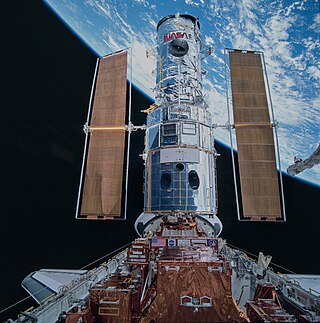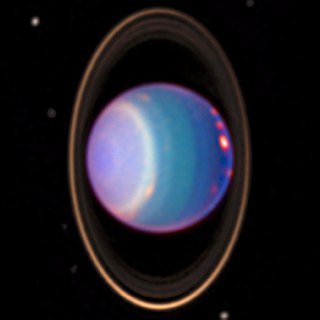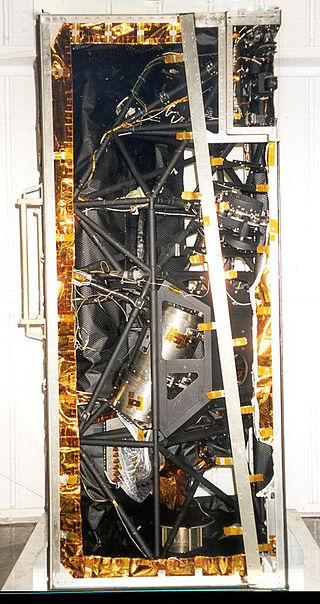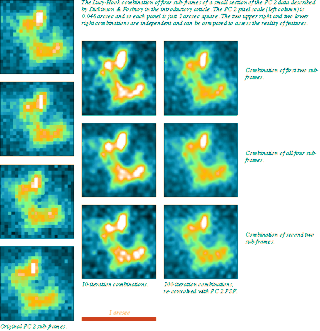Related Research Articles

The Hubble Space Telescope is a space telescope that was launched into low Earth orbit in 1990 and remains in operation. It was not the first space telescope, but it is one of the largest and most versatile, renowned as a vital research tool and as a public relations boon for astronomy. The Hubble telescope is named after astronomer Edwin Hubble and is one of NASA's Great Observatories. The Space Telescope Science Institute (STScI) selects Hubble's targets and processes the resulting data, while the Goddard Space Flight Center (GSFC) controls the spacecraft.

Astrophotography, also known as astronomical imaging, is the photography or imaging of astronomical objects, celestial events, or areas of the night sky. The first photograph of an astronomical object was taken in 1840, but it was not until the late 19th century that advances in technology allowed for detailed stellar photography. Besides being able to record the details of extended objects such as the Moon, Sun, and planets, modern astrophotography has the ability to image objects outside of the visible spectrum of the human eye such as dim stars, nebulae, and galaxies. This is accomplished through long time exposure as both film and digital cameras can accumulate and sum photons over long periods of time or using specialized optical filters which limit the photons to a certain wavelength.

The Hubble Deep Field (HDF) is an image of a small region in the constellation Ursa Major, constructed from a series of observations by the Hubble Space Telescope. It covers an area about 2.6 arcminutes on a side, about one 24-millionth of the whole sky, which is equivalent in angular size to a tennis ball at a distance of 100 metres. The image was assembled from 342 separate exposures taken with the Space Telescope's Wide Field and Planetary Camera 2 over ten consecutive days between December 18 and 28, 1995.

STS-82 was the 22nd flight of the Space Shuttle Discovery and the 82nd mission of the Space Shuttle program. It was NASA's second mission to service the Hubble Space Telescope, during which Discovery's crew repaired and upgraded the telescope's scientific instruments, increasing its research capabilities. Discovery launched from Kennedy Space Center, Florida, on February 11, 1997, returning to Earth on February 21, 1997, at Kennedy Space Center.

The Near Infrared Camera and Multi-Object Spectrometer (NICMOS) is a scientific instrument for infrared astronomy, installed on the Hubble Space Telescope (HST), operating from 1997 to 1999, and from 2002 to 2008. Images produced by NICMOS contain data from the near-infrared part of the light spectrum.

The Advanced Camera for Surveys (ACS) is a third-generation axial instrument aboard the Hubble Space Telescope (HST). The initial design and scientific capabilities of ACS were defined by a team based at Johns Hopkins University. ACS was assembled and tested extensively at Ball Aerospace & Technologies Corp. and the Goddard Space Flight Center and underwent a final flight-ready verification at the Kennedy Space Center before integration in the cargo bay of the Columbia orbiter. It was launched on March 1, 2002, as part of Servicing Mission 3B (STS-109) and installed in HST on March 7, replacing the Faint Object Camera (FOC), the last original instrument. ACS cost US$86 million at that time.

The Wide Field and Planetary Camera 2 (WFPC2) is a camera formerly installed on the Hubble Space Telescope. The camera was built by the Jet Propulsion Laboratory and is roughly the size of a baby grand piano. It was installed by servicing mission 1 (STS-61) in 1993, replacing the telescope's original Wide Field and Planetary Camera (WF/PC). WFPC2 was used to image the Hubble Deep Field in 1995, the Engraved Hourglass Nebula and Egg Nebula in 1996, and the Hubble Deep Field South in 1998. During STS-125, WFPC2 was removed and replaced with the Wide Field Camera 3 as part of the mission's first spacewalk on May 14, 2009. After returning to Earth, the camera was displayed briefly at the National Air and Space Museum and the Jet Propulsion Laboratory before returning to its final home at the Smithsonian's National Air and Space Museum.

The Faint Object Spectrograph (FOS) was a spectrograph installed on the Hubble Space Telescope. It was replaced by the Space Telescope Imaging Spectrograph in 1997, and is now on display in the National Air and Space Museum in Washington DC.

The Wide Field/Planetary Camera (WFPC) was a camera installed on the Hubble Space Telescope launched in April 1990 and operated until December 1993. It was one of the instruments on Hubble at launch, but its functionality was severely impaired by the defects of the main mirror optics which afflicted the telescope. However, it produced uniquely valuable high resolution images of relatively bright astronomical objects, allowing for a number of discoveries to be made by HST even in its aberrated condition.

The Hubble Deep Field South is a composite of several hundred individual images taken using the Hubble Space Telescope's Wide Field and Planetary Camera 2 over 10 days in September and October 1998. It followed the great success of the original Hubble Deep Field in facilitating the study of extremely distant galaxies in early stages of their evolution. While the WFPC2 took very deep optical images, nearby fields were simultaneously imaged by the Space Telescope Imaging Spectrograph (STIS) and the Near Infrared Camera and Multi-Object Spectrometer (NICMOS).

The Lucy–Hook coaddition method is an image processing technique for combining sub-stepped astronomical image data onto a finer grid. The method allows the option of resolution and contrast enhancement or the choice of a conservative, re-convolved, output.

A fine guidance sensor (FGS) is an instrument on board a space telescope that provides high-precision pointing information as input to the telescope's attitude control systems. Interferometric FGSs have been deployed on the Hubble Space Telescope; a different technical approach is used for the James Webb Space Telescope's FGSs. In some specialized cases, such as astrometry, FGSs can also be used as scientific instruments.
Tod R. Lauer is an American astronomer on the research staff of the NSF NOIRLab. He was a member of the Hubble Space Telescope Wide Field and Planetary Camera team, and is a founding member of the Nuker Team. His research interests includes observational searches for massive black holes in the centers of galaxies, the structure of elliptical galaxies, stellar populations, large-scale structure of the universe, and astronomical image processing. He was the Principal Investigator of the Destiny JDEM concept study, one of the precursors to the Nancy Grace Roman Space Telescope mission. Asteroid 3135 Lauer is named for him. He appears in an episode of the documentary series Naked Science. He joined the New Horizons Pluto team in order to apply his extensive experience with deep space imaging to the New Horizons data, yielding significantly clearer and mathematically accurate images of Pluto and Charon.

The Cosmic Origins Spectrograph (COS) is a science instrument that was installed on the Hubble Space Telescope during Servicing Mission 4 (STS-125) in May 2009. It is designed for ultraviolet (90–320 nm) spectroscopy of faint point sources with a resolving power of ≈1,550–24,000. Science goals include the study of the origins of large scale structure in the universe, the formation and evolution of galaxies, and the origin of stellar and planetary systems and the cold interstellar medium. COS was developed and built by the Center for Astrophysics and Space Astronomy (CASA-ARL) at the University of Colorado at Boulder and the Ball Aerospace and Technologies Corporation in Boulder, Colorado.

The Wide Field Camera 3 (WFC3) is the Hubble Space Telescope's last and most technologically advanced instrument to take images in the visible spectrum. It was installed as a replacement for the Wide Field and Planetary Camera 2 during the first spacewalk of Space Shuttle mission STS-125 on May 14, 2009.

Afocal photography, also called afocal imaging or afocal projection is a method of photography where the camera with its lens attached is mounted over the eyepiece of another image forming system such as an optical telescope or optical microscope, with the camera lens taking the place of the human eye.

Robert Gendler is an American physician, amateur astronomer, author and astrophotographer.
The Venus Spectral Rocket Experiment (VeSpR) was a suborbital rocket telescope that collected data on the ultraviolet (UV) light that is being emitted from Venus's atmosphere, which can provide information about the history of water on Venus. Measurements of this type cannot be done using Earth-based telescopes because Earth's atmosphere absorbs most UV light before it reaches the ground.

Adam David Block is an American astrophotographer, astronomy researcher, writer and instructor.
Monochrome photography is one of the earliest styles of photography and dates back to the 1800s. Monochrome photography is also a popular technique among astrophotographers. This is due to the omission of the Bayer filter, a colour filter array that sits in front of the CMOS or CCD sensor, allowing for a single sensor to produce a colour image.
References
- Fruchter A. S. & Hook R. N., Drizzle: A Method for the Linear Reconstruction of Undersampled Images, PASP, 114, 144.
- ↑ "Enhance! – AutoStakkert!". 25 January 2013.
- ↑ David Ratledge (2005). Digital Astrophotography: The State Of The Art. Springer. ISBN 1-85233-734-6.
- ↑ "DrizzlePac".
- ↑ "The DrizzlePac Handbook - HST User Documentation".